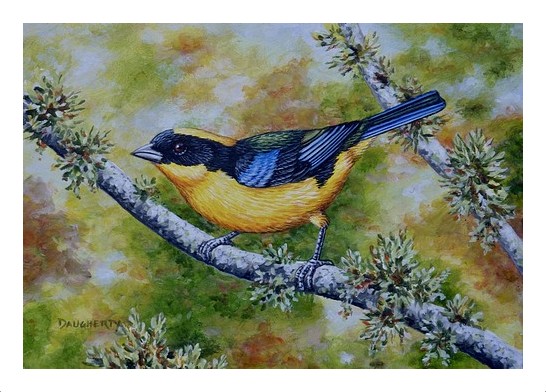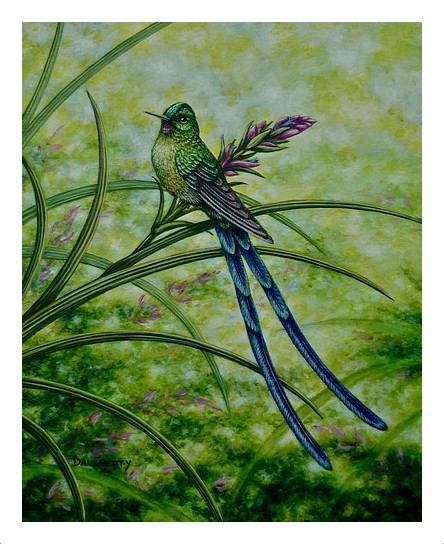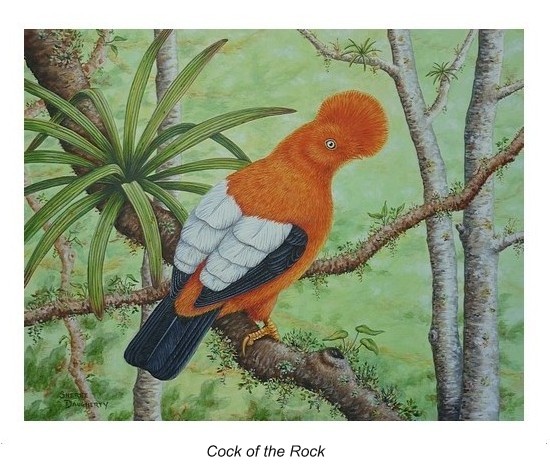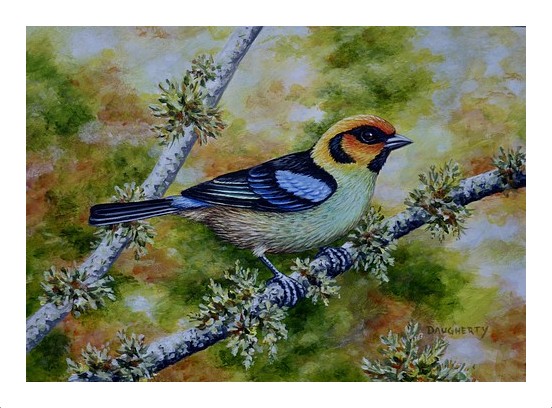Birding the Andes of Ecuador (March 15 - 23, 2019)

Friday, March 15
The Andes! Home to soaring peaks and the ancient Inca Empire. Also home to some of the most diverse birding hotspots on the planet! Fourteen intrepid adventurers on a birding tour to Ecuador arrived at the Mariscal Sucre International Airport 18 kilometers east of Quito at well past 10:00pm. A glowing golden half-moon hung sideways in the sky! Even the moon looked different at the equator!
It had been a rocky start due to the grounding of Boeing's 737 Max 8 fleet and subsequent flight rescheduling. We were fortunate to be able to stay fairly close to our schedule. Others were not so lucky. We heard reports of birding tours that missed a full day or even two of their long-planned trips because of the groundings and rescheduling.
Our trip covered a wide variety of habitats that ranged from an elevation of 3,000-4,000 feet to an ear popping high of 14,295 feet. Quito, the second highest capital in the world, is nestled in the Andes at 9,350 feet, nearly two miles above sea level. We would explore both the eastern and western slopes of the Andes Mountains. Rain that falls on the western slope goes to the Pacific Ocean. Rain falling on the eastern side eventually ends up in the Amazon River. And rain we had aplenty!
Our guide and driver were waiting for us at the airport. The luggage was packed into our big white bus, and we were shuttled to our hotel, the Rincon de Puembo, just outside of Quito. At the hotel revelers were celebrating an occasion with live music and fireworks. It wasn't for us, but I pretended that it was! Welcome to Ecuador!
Saturday, March 16
First, morning orientation with Edwin, our impressively knowledgeable Ecuadorian guide. Young Kevin, our in-country driver, was also a good addition to the group and proved to be a level-headed driver in the often chaotic traffic and on challenging roads. (Passing on narrow curves with sheer drop-offs seem to be an Ecuadorian national pastime!) As a bonus, Kevin was a fine birder too. Introductions and a gifts of woven bags from Holbrook Travel were passed out. The list they provided identified a mind boggling 1,603 bird species for Ecuador!
With over 130 species, Ecuador has almost half of the hummingbird species in the world. The names are enticing: Sparkling Violetear, Tourmaline Sunangel, Empress Brilliant, Shining Sunbeam and the largest hummingbird on earth, the aptly named Giant Hummingbird.
After a buffet breakfast, we headed to the bus and began the adventure. As we waited for the luggage to be loaded, we admired the volcano Pichincha, which could be seen in the distance. A few parking lot birds began our list: Saffron Finch, Golden-rumped Euphonia and Eared Dove. The roads near Quito were good; multi-lanes with many roundabouts. Since national elections were being held the following Sunday, banners flew and posters covered most flat surfaces encouraging voters to support candidates of one of the 71(!) political parties. Rallies and decorated vehicles at times slowed traffic. The most memorable was a flatbed truck featuring a large, blue Hulk figure accompanied by flag waving supporters. Voting is mandatory in Ecuador, so everyone feels involved.
We stopped briefly for a photo op at the Middle of the World Monument marking the equator. You can have one foot in each hemisphere!
Our first stop to look for birds was near Calacalí, Nono Road in the Tandayapa Valley. A Crimson-mantled Woodpecker, a red and yellow bird, was one of the first birds spotted. Who knew that woodpeckers came in that color combination!?

Just down the road we made a stop at the Alambi Cloud Forest Reserve. Feeders were busy. A pair of Red-headed Barbets and a shy Crimson-rumped Toucanet feasted on fruit. Some tanagers enjoyed the bananas too, including Golden, Silver-throated, Blue-grey and Flame-rumped. We took a hike and quickly found a Crested Quetzal, Great Thrush and a Squirrel Cuckoo. At the river we watched a Torrent Tyrannulet perched on a rock in midstream.
Along with the incredible birds, the flora was spectacular. Orchids of all sizes and shapes were found high and low. Unusual flowers were fascinating for those of us with an interest in plants. Many of the houseplants and annuals grown in the United States grow wild here.
The variety of butterflies was impressive too. The big Blue Morphos were breathtaking and dozens of unfamiliar species had cameras getting a workout.
Our day of birding ended, and we headed to the Sachatamia Lodge for a three night stay. The comfortable cabins are scattered throughout the property. The main lodge is shoe optional. You may enter in your socks or opt to pull on the provided booties over muddy shoes. The main lodge was where we reviewed our evening bird list and had our meals.
Sunday, March 17
To the blind before sunrise! A lighted sheet had lured in an assortment of insects and moths overnight, a smorgasbord for the birds. Fortune smiled and a female Long-wattled Umbrella Bird cautiously approached the blind. Her mate never appeared, but we enjoyed the unusual bird with an oddly feathered head for an extended period of time. A pair of Masked Trogons, Mountain Wrens, Uniform Antshrikes and Plain-brown Wood Creepers snatched bugs from the sheet. A migrating Swainson's Thrush dropped in to fuel up for the journey north.
After breakfast we piled into the bus and headed toward Bellavista Lodge. Needless to say, we birded along the way adding a striking Grass-green Tanager, Cinnamon Flycatcher and Plate-billed Mountain Toucan.
After lunch at Bellavista, we birded the property. Edwin's nephew works there and led us to a Great Potoo. Most potoos perch motionless during the day, head tilted to the sky, and look like stumps with tails. This one was no exception. Some in the group were not impressed!
Back near the lodge, we were treated to the sight of a stocky Toucan Barbet and several blue-bodied, red-eyed Masked Flowerpiercers. Everywhere we visited, the hummingbird feeders were busy. My favorites here were the tiny but feisty White-bellied Woodstars that buzzed loudly past the larger hummers.
Monday, March 18
We started the day with a drive on the red dirt road along the Silanche Río. Along the river we saw both Ringed and Green Kingfishers and a Black-crowned Tityra. Heading up and away from the river, new birds were showing up one after another. Raptors included a Hook-billed Kite, Gray Hawk and several Roadside Hawks. Lineated, Guayaquil and Golden-olive Woodpeckers represented that family. Some birds were unbelievably colorful: Bay-headed Tanager, Green Honeycreeper, Bronze-winged Parrots, Maroon-tailed Parakeets and Slate-colored Saltator.
How hard is it to find a Choco Toucan? Easy for others, but it took me forever! "It's in the big leaves next to the white barked tree in that little window," I was told. Frustrating! Finally, with a lot of help, I was able to see the endemic toucan. Thanks! Black-mandibled Toucans and Collared Ariçaris were easily spotted. Even by me!
Lunch was at Mirador Río Blanco restaurant. While we awaited lunch, we checked the sugar water and fruit feeders on the back patio. The rocky Río Blanco flowed through the deep valley below. We added Green Thorntails to the growing hummingbird list. Two Swallow-tailed Kites were mixed in with vultures riding the thermals above the Río Blanco. From the vantage point of the patio, we could enjoy the kites and vultures cruising by at eye level.
Tuesday, March 19
 It was another early morning departure. We left Mindo on the way to Refugio Paz de las Aves in the Sangolquí Valley to get to the lekking site of the Cock of the Rock before dawn (a lek is where birds gather to display). We could hear the loud calls while hiking down a steep path in the pre-dawn hour. In the dim light the cocks could be seen ping-ponging from tree to tree. As the light improved the brilliant orange plumage was stunning. At least a dozen males vied for position to impress the ladies. No females were seen. Perhaps the males were fueled by excessive testosterone and trying to impress each other.
It was another early morning departure. We left Mindo on the way to Refugio Paz de las Aves in the Sangolquí Valley to get to the lekking site of the Cock of the Rock before dawn (a lek is where birds gather to display). We could hear the loud calls while hiking down a steep path in the pre-dawn hour. In the dim light the cocks could be seen ping-ponging from tree to tree. As the light improved the brilliant orange plumage was stunning. At least a dozen males vied for position to impress the ladies. No females were seen. Perhaps the males were fueled by excessive testosterone and trying to impress each other.
The lek is managed by Angel Paz and his extended family. Angel is an internet sensation and is best known as the "Antpitta Whisperer." He has trained the shy antpittas to respond to the call of names he has given them and come out of the dense forest for a tasty worm. Angel's brother, Rodrigo, first took us to see some Dark-backed Wood Quail that, after some coaxing, came out for an easy snack. Next we went to see the first of three antpitta species. It took patience to get a long-blue-legged Chestnut-crowned Antpitta to show itself. The second stop was for a cooperative Yellow-bellied Antpitta. On the hike to see the third antpitta species, we spotted a Golden-headed Quetzal. The small Ochre-breasted Antpitta was my favorite. Two came into view and put on a show with wing twitches and a little shimmy. Angel has christened the Ochre-breasted Antpittas "Shakira" after the dancing Colombian singer.
After being charmed by the antpittas, we were treated to some traditional Ecuadorian food made by Rodrigo's wife, Diana Vera. Angel's son, Vinicio, served us big puffy empanadas and a dish made of green plantains. Most meals in Ecuador include the ever present bowl of Ají, a spicy sauce made from tree tomatoes and onions. Each café and lodge had their own version. All were unique and a welcomed addition to spice up our meals.
After we dined, a decorated birthday cake appeared. It was Diana Vera's birthday! Photos were taken, hugs were given, and songs were sung to honor the occasion.
Leaving Refugio Paz de las Aves was bittersweet. We were all moved by the warmth and welcoming hospitality of the Paz family. They have found a new and satisfying way of life by showing others the avian treasures of the region. Previously, they had farmed and cut down trees to support themselves. In this case the transformation to an ecotourism economy has been a win/win/win situation for wildlife, birders, and the people who live in Ecuador.
Heading back for another try on Nono Road, we picked up a pair of Sickle-winged Guan, a Rufous-chested and Blue-black Tanager and another look at a Crimson-mantled Woodpecker.
On the way to San Isidro, we were delayed by a routine police check point. It took an hour of slowly creeping along to get to the town. The upcoming national election was responsible for the delay. Alcohol is prohibited for three days before elections, and the locals were having a party on this last evening of revelry. The town was festive with live music and dancing. Young girls in colorful costumes performed synchronized dances. There were even a few cows and poncho-clad men on horseback thrown into the mix.
It was dark and rainy by the time that we arrived for dinner and a one night stay at Hacienda la Carriona. The hacienda, built more than 200 years ago, has been converted into a hotel. The five foot tall lighted cross in the courtyard seemed ancient and other worldly in the gloom. It had been a long, eventful day. We got our rooms, had a late dinner, and turned in for the night with anticipation of heading high into the Andes the next day.
Wednesday, March 20
The morning destination was the Antisana Ecological Reserve. The Andean Condors were surprisingly easy to find. Just look for the "white wash" on the rocky cliff faces. Both an adult and juvenile were found. While admiring the majestic condors, a Giant Hummingbird buzzed by. Several Black Flowerpiercers worked the surrounding shrubbery.
Climbing higher into the Andes vast fields of lima beans and potatoes were being hand-hoed by family groups of colorfully dressed locals. A brief stop on a bridge gave us a cleverly camouflaged Band-winged Nightjar to add to the list.
The landscape at 12,000+ feet was not what I had expected. Rolling plains of grass and low vegetation as far as the eye could see. Off in the distance, snow covered mountains and the volcano Antisana stood at 18,900 feet. Almost evenly spaced on the ground were Carunculated Caracaras and the very rare and declining Black-faced Ibis. Bright white flocks of Andean Gulls swirled through the air. A Variable Hawk was spotted along with Paramo Pipits and a single Black-winged Ground Dove be-bopped down the ditch along the road. An American Kestrel and an Aplomado Falcon perched on posts near the road.
Cattle grazed the grassland, but few native mammals were seen. Brazilian Rabbits were abundant along the road, and a few White-tailed Deer were spotted (probably a sub-species of our version).
Laguna Mica is a high altitude lake set at 12,841 feet. The lake is locally known as Micacocha, a hybrid of the Spanish word for mica, a shiny mineral, and the Quichua word cocha, meaning body of water. Laguna Mica provides drinking water to the city of Quito. We find Andean Teal, Slate-colored Coot, Ruddy Ducks, and Silvery Grebes. According to the Helm Field Guide: Birds of Ecuador, the Silvery Grebes are very rare and numbered only in the hundreds in Ecuador.
Black-tailed Trainbearers, Shining Sunbeams and Great Sapphirewing Hummingbirds shared lunchtime with us at a local restaurant. A Giant Hummingbird struck a pose for everyone to admire. A Sword-billed Hummingbird made a quick pass that was only a blur. Sorry, can't count that! A Black-chested Buzzard Eagle soared over head.
Earlier in the day Edwin had replied "no" to my question if he had ever experienced snow? That was soon to change. Snow had fallen earlier and looked like hailstones suspended in thick slush. The snow patches covered the road as we drove on the highway to Cayembe Coca.
We turned off the highway and started up a snow-covered dirt road. The bus clung to the side of the mountain as we climbed. A Red-rumped Brush Tyrant, a rare bird, caused us to pause. Then a Tawny Antpitta ran up the snowy road. We were headed to the highest elevation of the trip, 14,295 feet. Cell towers adorned the peak. Everyone had five bars! Two Andean Foxes were very casual about our presence. They did not run away but seemed curious and kept a short distance from us. Edwin and Kevin waded through the slush around the towers in search of a snipe. The rest of us were feeling the effects of the high altitude. We were also speculating about the safety of getting back down the mountain in a giant bus on a narrow gravel road coated with an inch of graupel. Was this the ultimate "Snipe Hunt?" We did not see any snipe. If only someone had brought a bag....
Back to middle elevations of 6,000 to 7,000 feet and birding on the way to our next overnight stay at San Isidro Lodge. We found a few nice birds en route, the beautiful Turquoise Jay and a Hooded Mountain Tanager.
Arriving at the lodge after dark, a San Isidro Owl, a sub species of the Black-and-White Owl, was spotted before we unloaded luggage. Their calls were heard through the night. It was the perfect welcome.
Thursday, March 21
It was a rainy day (again!) as we headed out to bird a nearby road. We walked and Kevin followed in the bus. The dirt and gravel road had one serious wash out that gave us pause. Kevin expertly drove the big bus around the treacherous spot. Afterward, raucous Green Jays, similar in appearance to the Green Jays found in Texas, were stunning when caught in good light.
Strong-billed Woodcreeper, Chestnut-breasted Coronet, Mountain and Scarlet-rumped Cacique and Russet-backed Oropendola add to the trip's list of birds.
We stopped on a bridge that spanned a rocky, swiftly flowing river. A pair of Torrent Ducks fed by diving into the rapids. Another Torrent Tyrannulet and a pair of White-capped Dippers did the same.
One more hummingbird feeder stop at Brisas de Baeza was abuzz with hummers. A subspecies of the Booted Racket-tail sported peach colored pantaloons instead of the cottony white ones. White-tailed Hillstar, Violet-fronted Brilliant and Tawny-bellied Hermit expanded the list of hummers. New passerines found include Yellow-browed Sparrow and Olivaceous Siskin.
Back in the bus to another stop and a short hike to see a resting Swallow-tailed Nightjar. The nightjar sat motionless only a few feet from the trail and we quietly enjoyed the intricate markings in many shades of brown.
Friday, March 22
It's another wet day. Fortunately, everyone was well prepared with rain gear. We birded the trails on the grounds of Guango Lodge. A Masked Hemiphinus, Mountain Wren, and Andean Potoo were found.
We enjoyed a lovely traditional lunch at Guango Lodge. As at almost every lunch and dinner, the first course of soup was warming on this chilly, wet day. The main course was a delicious rice, chicken, and egg dish cooked in banana leaves.
Heading back toward Quito, we stopped in the Cumbayá Valley to visit the home of artist and ornithologist Juan Manuel Carrion. Juan welcomed us into his beautiful art-and-artifact-filled home. After a talk about the local culture, he serenaded us on a variety of percussion, wind, and stringed instruments. A tour of his studio was an opportunity to see some works in progress. A huge Galápagos Tortoise sculpture was being covered in paintings of the native plants and animals of the famous island group. Señor Carrion was a man of diverse interests. He took great pride in his country and was running for City Council in an attempt to focus attention on preserving Ecuador's natural resources.
We were shuttled back to where we began, hotel Rincon de Puembo. Our airport schedule had been changed to a dreadful red-eye flight, so instead of a chance to get a nap, we had dinner, organized our luggage, and headed to the airport for a midnight flight. The rescheduled flight made for a long nine hour layover in Miami, but we finally got home in the late afternoon on Saturday, March 23.
It was a trip of a life time! The iconic Andean Condor and almost 40 types of hummingbirds were highlights of the more than 250 bird species we saw. The varied landscapes, from primeval cloud forests to the awe-inspiring high Andes, the warm and friendly people, the delicious, exotic food, and a great group of traveling mates made for an experience that we will all remember fondly for years to come.
Finally, many thanks to Holbrook Travel and the Audubon Society of Western Pennsylvania for organizing this amazing experience!
Thanks!
— by Sheree Daugherty
Original paintings of Ecuadorian birds by the author






